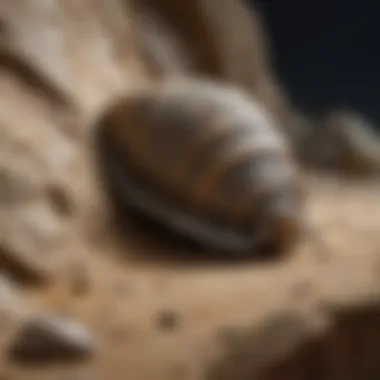Unearthing the Secrets: A Profound Exploration of Fossils and their Geological Impact


Rock and Fossil Identification
In this first section, we will delve into the intricate world of rock and fossil identification. Understanding the different types of rocks and fossils is crucial in deciphering Earth's ancient history. Rocks can range from sedimentary to igneous and metamorphic, each telling a unique tale of geologic processes. Fossils, on the other hand, offer glimpses into long-gone epochs, preserving remnants of ancient life forms.
To identify these geological treasures, one must be observant of distinct characteristics. Textures, colors, patterns, and formations all provide valuable clues to the rock or fossil's origin and history. Fossils may exhibit detailed imprints of prehistoric organisms or show mineral replacement indicating their petrified nature. Meanwhile, rocks can display layering, crystals, or fossil inclusions. By keenly noting these features, enthusiasts can unlock the stories embedded in these natural artifacts.
Various tools aid in the identification process, ranging from simple hand lenses to advanced microscopes. Hand lenses allow for detailed examination of texture and structure, essential in distinguishing between rock types. Microscopes provide high-resolution views, enabling precise analysis of fossilized specimen details. Alongside these optical instruments, chemical tests and X-ray fluorescence can offer valuable insights into mineral composition. Utilizing these tools effectively enhances the accuracy and depth of rock and fossil identification.
Introduction
In the vast expanse of geological wonders, fossils stand as enigmatic gateways to the mysteries of Earth's history. These petrified remains, frozen in time, offer a unique perspective on the evolution of life and landscapes over millennia. Their significance transcends mere artifacts, encapsulating a bygone era in intricate detail. As we embark on this journey of discovery, we peel back the layers of time to reveal the profound secrets that fossils hold within their stone embrace.
Understanding the Fascination
Connection to Earth's History
In the realm of paleontology, the connection to Earth's history serves as a pivotal link bridging ancient epochs with the present. These fossilized remnants document the evolutionary tapestry of life, allowing us to reconstruct the narrative of our planet's past. The stratigraphic layers encapsulated within fossils offer a tangible timeline, depicting the rise and fall of species long gone. This historical connectivity immerses us in a deep understanding of the interconnectedness of life forms and the cyclical nature of Earth's ecosystems.
Scientific Curiosity
Scientific curiosity fuels the pursuit of uncovering fossils, driving researchers to delve into the depths of geological formations in search of paleontological treasures. The insatiable quest for knowledge pushes boundaries, challenging conventional wisdom and leading to groundbreaking discoveries. Through rigorous scientific inquiry, curiosity guides paleontologists in unraveling the enigmas concealed within fossilized remnants. This relentless pursuit of understanding epitomizes the inherent human drive to comprehend the complexities of our natural world.
The RelictVibe Portal
Brief Description
Within the digital landscape of paleontological exploration, the Relict Vibe portal emerges as a beacon of information and camaraderie for enthusiasts and experts alike. This virtual hub provides a platform for sharing research findings, engaging in scientific discourse, and fostering a community dedicated to the preservation of paleontological heritage. The concise yet comprehensive nature of the RelictVibe portal offers a gateway to a realm where past and present converge, fueling scholarly pursuits and igniting intellectual curiosity.
Detailed Description
Delving deeper into the intricacies of the Relict Vibe portal reveals a mosaic of resources tailored to cater to a diverse audience of fossil aficionados. From detailed taxonomy databases to interactive virtual exhibits, the portal encapsulates a myriad of features designed to immerse visitors in the world of paleontology. Its user-friendly interface ensures seamless navigation, facilitating easy access to a treasure trove of information on fossils, geological records, and scientific advancements.


Target Audience
The target audience of the Relict Vibe portal spans a broad spectrum of individuals united by a shared passion for fossils and the geological sciences. Amateur collectors, seasoned researchers, educators, and students form a mosaic of users who frequent the portal in pursuit of knowledge and exploration. By catering to this diverse demographic, the RelictVibe portal fosters a collaborative environment where expertise converges, ideas flourish, and a deeper understanding of paleontological phenomena is cultivated.
Exploring Fossilization
In this meticulous examination of fossils and their geological implications, the section on Exploring Fossilization takes center stage, shedding light on crucial elements that define our understanding of ancient relics. By dissecting the fossilization process, we unravel a tapestry of historical significance and scientific intrigue that unveils Earth's secrets like never before. This deep dive into fossils not only educates but also inspires a new appreciation for our planet's rich past.
Formation Process
Sedimentation
Considering the process of Sedimentation within the realm of fossilization, one cannot overlook its pivotal role in preserving remnants of bygone eras. This natural mechanism of layering sediments plays a crucial part in fossil formation by creating a conducive environment for organic materials to be encased and transformed over time. Sedimentation's ability to encapsulate and protect biological remains is fundamental to the preservation of fossils, offering a snapshot of ancient life amidst geological changes.
Mineralization
Mineralization, another key facet of the fossilization process, adds a layer of complexity to the formation of fossils. Through the gradual replacement of organic matter with minerals, the intricate structures of organisms are immortalized in stone, providing a lasting record of past life forms. This transformation not only solidifies the delicate features of ancient organisms but also highlights the mineral-rich nature of the surrounding environment that contributes to fossilization.
Fossilization Conditions
Delving into the specific conditions required for fossilization, we uncover the delicate balance necessary for the preservation of organic material. Factors such as temperature, pressure, and chemical composition play a critical role in determining the success of fossilization processes. Understanding these precise conditions gives us insight into the rarity and preciousness of well-preserved fossils that offer significant scientific value.
Types of Fossils
Permineralization
One of the primary types of fossils, permineralization, captures the essence of organisms by mineral encasement, preserving intricate details that paint a vivid picture of ancient life. This process of gradual mineral infiltration ensures the longevity of fossils, allowing researchers to study the biological structures with astonishing clarity. The unique feature of permineralization lies in its ability to retain the original morphology of organisms, providing valuable insights into evolutionary patterns.
Molds and Casts
The formation of molds and casts represents a distinct method of fossilization, where original organisms leave imprints that are later filled with sediment, creating a replica of the once-living being. This type of fossilization offers a three-dimensional view of extinct species, showcasing their shapes and contours in a tangible form. The advantage of molds and casts lies in their ability to capture the external features of organisms in a lifelike representation.
Replacement


Within the spectrum of fossilization, replacement stands out as a process where the original organic material is replaced by minerals, resulting in a durable fossil specimen. This method preserves the structural integrity of organisms while fundamentally altering their chemical composition, offering researchers a preserved record of ancient life forms. The unique feature of replacement lies in its ability to maintain the impression of organisms while transforming their essence into stony relics, suitable for detailed analysis and scientific scrutiny.
Significance of Fossils
Fossils hold a paramount position in the realm of paleontology, offering a unique window into the Earth's ancient past. Within the scope of this article, the Significance of Fossils plays a pivotal role in unraveling the mysteries embedded in the geological record. By examining fossils, researchers can discern evolutionary patterns and environmental shifts that have shaped the planet over millennia. The preservation of fossils offers invaluable insights into past ecosystems and species interactions, contributing significantly to our understanding of Earth's history.
Scientific Insights
Evolutionary Studies
Evolutionary Studies form the cornerstone of paleontological research, focusing on the gradual development and diversification of life forms through time. This discipline allows scientists to trace the evolutionary lineage of organisms, deciphering key transitions and adaptations that have occurred over geological ages. In the context of this article, Evolutionary Studies play a crucial role in analyzing fossil specimens to deduce ancestral relationships and evolutionary pathways. The systematic analysis of morphological features and genetic information equips researchers with the tools to construct detailed evolutionary scenarios, shedding light on the origins of species and the mechanisms driving biological diversity.
Environmental Indicators
The study of fossils as Environmental Indicators provides essential clues about past climatic conditions, ecological dynamics, and environmental changes. By examining the distribution of fossil assemblages and the ecological requirements of ancient organisms, researchers can infer information about past environments and the impact of climatic fluctuations on biodiversity. In the context of this article, Environmental Indicators serve as valuable tools for reconstructing past ecosystems and monitoring long-term environmental trends. The ability of fossils to record subtle environmental variations offers a unique perspective on how ecosystems have responded to geological events and climatic shifts throughout Earth's history.
Educational Value
Hands-On Learning
Hands-On Learning in paleontology immerses students and enthusiasts in the practical aspects of fossil discovery, excavation, and analysis. This experiential approach fosters a deeper appreciation for the scientific processes involved in paleontological research, allowing individuals to engage directly with the material remains of ancient life forms. In the context of this article, Hands-On Learning empowers readers to explore the methods and techniques used by paleontologists, providing valuable insights into the challenges and opportunities of working with fossil specimens firsthand.
Historical Context
Understanding fossils within their Historical Context broadens our perspective on the interconnectedness of geological processes, evolutionary changes, and human interactions throughout time. By contextualizing fossils within the framework of historical events and scientific discoveries, we can appreciate the evolutionary narratives and geological transformations that have shaped our planet. In the context of this article, Historical Context enriches our comprehension of how fossils are integrated into broader narratives of scientific inquiry, cultural heritage, and environmental stewardship. Exploring the historical backgrounds of fossil discoveries enhances our awareness of the complex trajectories that have led to our current understanding of Earth's past.
Excavating the Past
Excavating the Past plays a pivotal role in unveiling the secrets of fossils and their geological significance. In this section, we delve into the intricate process of uncovering ancient remnants from the Earth's crust. The importance of fieldwork techniques cannot be overstated when it comes to excavating fossils. Not only does it provide clues about the past, but it also helps in understanding the geological history of a particular region. By meticulously excavating fossil sites, researchers can reconstruct past ecosystems and climates, shedding light on evolutionary patterns and environmental changes. Fieldwork techniques help in preserving delicate specimens and ensuring that valuable information is not lost in the process.
Fieldwork Techniques
Digging Methods


Digging Methods are the cornerstone of any successful excavation project. These methods involve careful removal of sediment layers to expose fossilized remains without causing damage. One key characteristic of Digging Methods is their precision in extracting fossils while maintaining the integrity of the surrounding strata. This precision is crucial in piecing together the intricate puzzle of Earth's history, as it allows researchers to analyze the spatial distribution of fossils and their relation to each other. Despite being a time-consuming process, Digging Methods are essential for acquiring accurate data and preserving valuable specimens for further study.
Site Preservation
Site Preservation is another vital aspect of fieldwork techniques that cannot be overlooked. Preservation of fossil sites ensures that valuable information is retained for future generations of scientists to analyze. The key characteristic of Site Preservation lies in protecting exposed fossils from environmental factors such as erosion, weathering, and human interference. By implementing stringent conservation measures, researchers can safeguard fossil sites from degradation and unauthorized access. Site Preservation plays a crucial role in maintaining the integrity of fossil-rich locations, allowing for systematic exploration and documentation of unique specimens.
Tools of the Trade
Brushes and Picks
Brushes and Picks are essential tools in the arsenal of a field paleontologist. These tools are specifically designed for delicate excavation work, enabling researchers to carefully remove sediment and debris from fossil surfaces. One key characteristic of Brushes and Picks is their ability to precision in clearing away matrix material without damaging the underlying fossil. This precision is instrumental in revealing intricate details preserved in the fossilized remains, enhancing the overall understanding of the specimen. While Brushes and Picks require skill and patience to wield effectively, their contribution to accurately uncovering fossils is invaluable in paleontological research.
Screening Equipment
Screening Equipment plays a critical role in the final stages of fossil excavation. This equipment allows researchers to sift through sediments from excavation sites, separating fossil fragments from debris. One key characteristic of Screening Equipment is its efficiency in sorting and categorizing fossil specimens based on size and density. This efficiency streamlines the process of fossil recovery, enabling researchers to identify and collect valuable remains with precision. Despite the time commitment required for screening sediment samples, this method is indispensable for recovering small or fragile fossils that may otherwise go unnoticed. By employing Screening Equipment, researchers can enhance the thoroughness and accuracy of their excavation processes, ensuring that no significant findings are overlooked.
Preservation and Display
In the world of paleontology and geology, the preservation and display of fossils hold immense importance. Proper preservation ensures the longevity and integrity of these invaluable artifacts, allowing them to communicate stories from millions of years ago. Display, on the other hand, serves as a platform for education and admiration, connecting the audience with the Earth's ancient past. Preservation methods range from stabilizing fragile fossils to safeguarding them against environmental factors. Similarly, effective display strategies aim to showcase these relics in a visually appealing and informative manner, enhancing the overall experience for viewers. Through meticulous preservation and thoughtful display, fossils can continue to fulfill their role as crucial geological and historical evidence.
Conservation Methods
Stabilization Techniques
Stabilization techniques play a pivotal role in preserving fragile fossils for future generations. By utilizing specialized materials and methods, experts can reinforce weakened structures, ensuring the long-term durability of these specimens. The key characteristic of stabilization techniques lies in their ability to strengthen delicate fossils without causing damage or altering their original form. This aspect makes stabilization techniques a popular choice in ensuring the integrity of fossils showcased in this article. One unique feature of stabilization techniques is their adaptability to various types of fossils, ranging from small delicate specimens to large complex formations. While stabilization techniques offer numerous benefits, such as increasing the lifespan of fossils, they also come with the challenge of maintaining authenticity and minimizing intervention to preserve the fossils' scientific value.
Storage Considerations
When exploring preservation methods, storage considerations play a pivotal role in maintaining the quality and longevity of fossils. Proper storage practices involve controlling environmental factors such as temperature, humidity, and light exposure to prevent degradation. The key characteristic of storage considerations lies in their ability to create optimal conditions for fossil preservation, preventing deterioration and structural damage. This feature makes storage considerations a beneficial choice for safeguarding fossils showcased in this article. One unique aspect of storage considerations is the emphasis on archival-quality materials and controlled environments to ensure the integrity of fossils over time. While storage considerations offer advantages in prolonging the lifespan of fossils, the challenges include the cost and resources required to maintain ideal storage conditions, especially for extensive fossil collections.
Showcasing Fossils
Exhibit Design
The design of fossil exhibits plays a crucial role in engaging audiences and conveying scientific information effectively. Exhibit design focuses on creating immersive environments that showcase fossils in a visually appealing and contextually relevant manner. A key characteristic of exhibit design is its ability to tell stories through spatial layout, interpretive elements, and interactive displays, enhancing the educational value for visitors. This characteristic makes exhibit design a popular choice for museums and educational institutions looking to display fossils in a captivating way. A unique feature of exhibit design is its integration of modern technologies, such as virtual reality and multimedia presentations, to bring fossils to life and offer a dynamic viewing experience. While exhibit design offers advantages in enhancing visitor engagement and knowledge retention, challenges include balancing educational content with aesthetic appeal and ensuring accessibility for diverse audiences.
Lighting and Temperature Control
Effective lighting and temperature control are essential components of fossil display environments, contributing to the preservation and visibility of specimens. Optimal lighting highlights the texture, color, and details of fossils, creating an immersive viewing experience for visitors. Temperature control is critical in preventing fluctuations that can harm fragile fossils and ensuring a stable environment for long-term display. The key characteristic of lighting and temperature control is their impact on the visual presentation and conservation of fossils, enhancing their aesthetic appeal and longevity. This characteristic makes lighting and temperature control a beneficial choice for maintaining fossil exhibits in this article. One unique feature of lighting and temperature control is their integration with conservation practices, striking a balance between showcasing fossils effectively and preserving them for future generations. While these elements offer advantages in elevating the display quality and protection of fossils, challenges include energy efficiency concerns and maintenance costs associated with maintaining optimal lighting and temperature levels.







